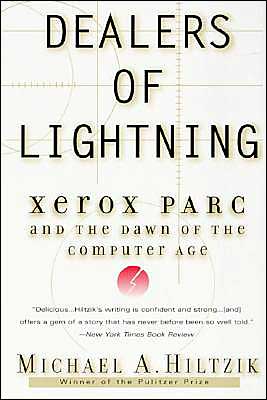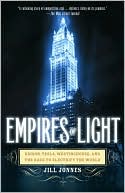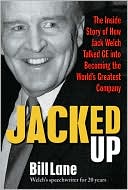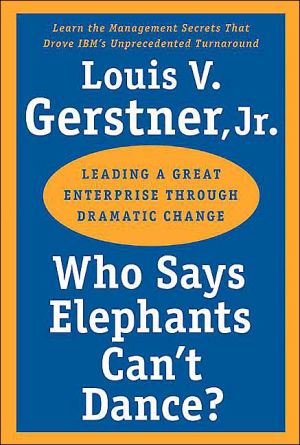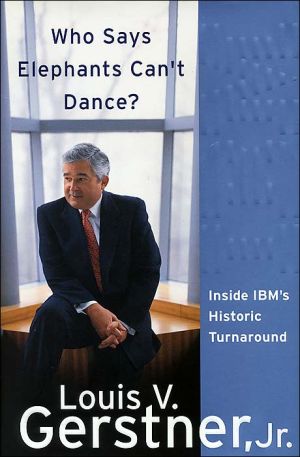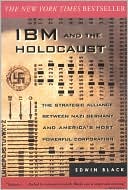Dealers of Lightning: Xerox PARC and the Dawn of the Computer Age
In the bestselling tradition of The Soul of a New Machine, Dealers of Lightning is a fascinating journey of intellectual creation. In the 1970s and '80s, Xerox Corporation brought together a brain-trust of engineering geniuses, a group of computer eccentrics dubbed PARC. This brilliant group created several monumental innovations that triggered a technological revolution, including the first personal computer, the laser printer, and the graphical interface (one of the main precursors of the...
Search in google:
While Gates, Jobs, and the other big boys of Silicon Valley are basking in the glory of the information age, renowned Los Angeles Times reporter Hiltzik reveals how, back in the early '70s, a group of little-known inventors at Xerox's Palo Alto Research Center (PARC) blazed the trail for all of today's indispensable technology — from the PC to email to ATMs to meteorologists' weather maps. And they did it without fanfare or recognition from their employer. This fascinating look at techno-history sets the record straight. Electronic Review of Books - Michael Swaine The founder of Federal Express got a C on the college paper he wrote describing the idea for his company. FedEx and its competitors are doing pretty well now. Although I don't agree with Hiltzig that the Alto was the world's first personal computer, that's just a matter of different definitions -- his strictly technological, mine involving price and marketing as well. I have a few other quibbles with the book, but, overall, I found it highly readable and seemingly authoritative. In writing the book, Hiltzig drew on the recollections of those who were there, interviewing all the obvious suspects and not a few innocent bystanders. The book is worth reading just to remind yourself of the amazing invention machine PARC was -- and of the amazing collection of inventors who were there. The development of the Alto, of course, but also: Jim Clark (the cofounder of Netscape) designing the Geometry Engine as part of a PARC-supervised course at Stanford and launching Silicon Graphics on the strength of it. Lynn Conway (of Mead and Conway, the most well-known names in VLSI) developing the design techniques and tools to make VLSI a practical reality. An offhand remark to Gary Starkweather leading to the invention of the laser printer. Bob Metcalfe sifting through various networking options and coming up with Ethernet. Alan Kay telling Dan Ingalls and Ted Kaehler that the most powerful programming language in the world could be specified in one page and, when challenged to put up or shut up, inventing Smalltalk. Bob Taylor recruiting Bill English away from Doug Engelbart and getting access to the mouse and all the other goodies of Engelbart's lab. Charles Simonyi inventing WYSIWYG. Dan Ingalls shocking the crowd when he demonstrated bitblt. John Warnock and Chuck Jeschke creating page-description languages. Alvy Ray Smith coming up with the HSV transformation. Hiltzig describes PARC's origins, the recruitment of talent, its culture, people, politics, and projects. He also spends a chapter on the question, "Did Xerox blow it?" That strikes me as overkill for a question that can be answered in a word -- Duh! But I don't mean to belittle Hiltzig's analysis of the politics of PARC. He does an impressive job of telling not only what happened, but why and how it happened, and how Xerox management both hindered and empowered this amazing band of inventors. If this is failure, we should all be so unsuccessful.
Chapter One\ \ The Impresario\ \ The photograph shows a handsome man in a checked sport shirt, his boyish face half-obscured by a cloud of pipe smoke. Robert W. Taylor looks amused and slightly out of date, his sandy hair longer than one might wear it today but unfashionably short for the distant time period when the picture was taken by the famous photographer of a trendy magazine. His gaze is fixed on something beyond the camera as though contemplating the future, which would befit the man who brought together perhaps the greatest collection of computer engineering talent ever to work in one place.\ On a sunny afternoon in July 1996 the same photograph looked down at a gathering of that same talent in the open-air restaurant of a Northern California winery. There were some changes from when it was first shot, however. This time the picture was blown up bigger than fife, and the people celebrating under its amused gaze had aged a quarter-century\ They were there to mark the retirement of Bob Taylor, the unlikely impresario of computer science at Xerox PARC. Among the guests were several of his intellectual mentors, including a few who ranked as genuine Grand Old Men of a young and still-fluid discipline. This group included Wes Clark, an irascible genius of hardware design who started his career when even the smallest computers had to be operated from within their cavernous entrails; and seated not far away, the flinty Douglas C. Engelbart, the uncompromising prophet of multimedia interactivity whose principles of graphical user interfaces and mouse-click navigation were disdained in his own time but have become ubiquitous inours.\ Most of the company, however, consisted of Bob Taylor's chosen people. They were unabashed admirers whose careers he had launched by inviting them to sit beneath his commodious wing. Geniuses, prodigies, owners of doctorates from the leading halls of learning, they lived in the thrall of this psychologist from The University of Texas who stammered frightfully when trying to communicate an abstruse technical point, yet still managed to impart a vision of computing that reigns today on millions of desktops. Many moved on to more splendid achievements and some to astounding wealth. But none ever forgot how profoundly their professional lives were changed when Bob Taylor fixed them with his discerning eye and invited them to enlist in his tiny company of believers.\ "As a leader of engineers and scientists he had no equal," said Chuck Thacker, who worked beside him longer than almost anyone else. "If you're looking for the magic, it was him."\ Thacker served as the afternoon's master of ceremonies. Under his deft supervision the familiar old Bob Taylor stories got dusted off to be howled over anew. Bob arranging for Dr Pepper, the Texas state drink, to be imported into PARC "by the pallet load and stored in a special locked vault." Bob bombing through the streets of Washington in his Corvette Stingray as though saddled on a wild stallion. Or rigging his Alto to beep out "The Eyes of Texas Are Upon You" whenever he received an e-mail message on PARC's unique internal network. Taylor listened to it all in great good humor from the table of honor, way in the back, dressed in a short-sleeved striped shirt and resplendent cherry-red slacks. But then, nothing ever pleased him more than functioning as the lodestar of the proceedings while pretending to be nothing but an unassuming bystander.\ Charles Simonyi, who was a naive young Hungarian immigrant without a green card when Taylor brought him to PARC in 1972, flew down from Seattle in his own Learjet, one of the perquisites that accrue to a man who moved from PARC to become employee number forty of a small company named Microsoft.\ "I remember Bob preparing me to deal with the three most powerful forces of the twentieth century," he said. "One of these was personal distributed computing. The second was the Internet. And the third very powerful force is football."\ Appreciative laughter rippled across the floor. Everyone present understood football as an emblem of the darker currents driving Bob Taylor's personality and career. They knew that as a competitor he was an absolutely ruthless creature and that to protect and glorify the work of his group he would blindly trample anyone in the way like a fullback scenting the goal line-be they rivals, superiors, or members of his own circle judged to have fallen prey to heretical thoughts.\ Over the years these habits left a trail of roasted relationships. Most of the guests at the retirement lunch were polite enough not to remark openly that the company giving Taylor the gold watch was Digital Equipment Corporation, not Xerox. Or that among the party's conspicuous absentees were George Pake, who had hired him to establish and oversee the computer science laboratory at PARC, and Pake's successor, Bill Spencer, who evicted Taylor from PARC more than a decade later. The common knowledge was that for every guest who owed a career to the guest of honor there existed not a few individuals who had felt the sting of Taylor's rivalry and damned him as one of the most arrogant, elitist, and unprincipled persons on the planet.\ The allusions to this discomfiting truth were mostly indirect. At his touch football games, it was recalled, he was always the quarterback. The former PARC engineer Dick Shoup recalled how at softball Taylor would invariably wave A the other infielders off a pop-up. One day Shoup complained, "Bob, the other people came to play, tool"...
Cast of CharactersTimelineIntroduction: The Time MachinePt. IProdigiesCh. 1The Impresario3Ch. 2McColough's Folly21Ch. 3The House on Porter Drive33Ch. 4Utopia52Ch. 5Berkeley's Second System68Ch. 6"Not Your Normal Person"80Ch. 7The Clone97Ch. 8The Future Invented117Pt. IIInventorsCh. 9The Refugee127Ch. 10Beating the Dealer145Ch. 11Spacewar155Ch. 12Thacker's Bet163Ch. 13The Bobbsey Twins Build a Network178Ch. 14What You See Is What You Get194Ch. 15On the Lunatic Fringe211Ch. 16The Pariahs229Ch. 17The Big Machine242Pt. IIIMessengersCh. 18Futures Day259Ch. 19Future Plus One274Ch. 20The Worm That Ate the Ethernet289Ch. 21The Silicon Revolution300Ch. 22The Crisis of Biggerism314Ch. 23Steve Jobs Gets His Show and Tell329Ch. 24Supernova346Ch. 25Blindsided361Ch. 26Exit the Impresario371Epilogue: Did Xerox Blow It?389Afterlives399Source Notes405Glossary of Selected Terms415Bibliography419Acknowledgments423Index427
\ From Barnes & NobleThe Barnes & Noble Review\ March 1999\ \ While Gates, Jobs, and the other big boys of Silicon Valley are basking in the glory of the information age, renowned Los Angeles Times reporter Michael Hiltzik reveals how, back in the early '70s, a group of inventors at Xerox's Palo Alto Research Center (PARC) blazed the trail for all of today's indispensable technology — from the PC to email to ATMs to meteorologists' weather maps. And they did it without fanfare or recognition from their employer. Hiltzik's Dealers of Lightning provides a fascinating look at technohistory that sets the record straight. \ In Dealers of Lightning, Hiltzik describes the forces and faces behind the revolution that the Xerox PARC team single-handedly spawned. The Xerox PARC group was composed solely of top technical minds. The decision was made at Xerox headquarters to give the team complete freedom from deadlines and directives, in hopes of fostering a true creative environment. It worked — perhaps too well. The team responded with a steady output of amazing technology, including the first version of the Internet, the first personal computer, user-friendly word-processing programs, and pop-up menus. Xerox, far from ready for the explosion of innovation, failed to utilize the technology dreamed up by the group. Out of all the dazzling inventions born at Xerox PARC, only a handful were developed and marketed by Xerox. However, one of these inventions, the laser printer, proved successful enough to earn billions for the company, therefore justifying its investment in the research center. Most oftheteam's creations would go on to be developed and perfected by other companies, such as IBM, Apple, and Microsoft.\ Drawing from interviews with the engineers, executives, and scientists involved in the Xerox PARC, Dealers of Lightning chronicles an amazing era of egos, ideas, and inventions at the dawn of the computer age.\ \ \ \ \ \ David Pogue...[L]ong, overly detailed but ultimately rewarding....It's almost agonizing to contemplate the missed opportunities....Xerox could easily have become the Microsoft of the era....[F]or any student of business or technology, Dealers of Lightning offers a gem of a story that has never been so well told. \ —The New York Times Book Review\ \ \ Michael MattisAs tech books go, Dealers of Lightning is a veritable ripsnorter; a great read that's also a must read for anyone who purports to deal in innovation. \ — Business 2.0\ \ \ \ \ Michael SwaineThe founder of Federal Express got a C on the college paper he wrote describing the idea for his company. FedEx and its competitors are doing pretty well now.\ Although I don't agree with Hiltzig that the Alto was the world's first personal computer, that's just a matter of different definitions -- his strictly technological, mine involving price and marketing as well. I have a few other quibbles with the book, but, overall, I found it highly readable and seemingly authoritative. In writing the book, Hiltzig drew on the recollections of those who were there, interviewing all the obvious suspects and not a few innocent bystanders.\ The book is worth reading just to remind yourself of the amazing invention machine PARC was -- and of the amazing collection of inventors who were there.\ The development of the Alto, of course, but also:\ \ Jim Clark (the cofounder of Netscape) designing the Geometry Engine as part of a PARC-supervised course at Stanford and launching Silicon Graphics on the strength of it.\ Lynn Conway (of Mead and Conway, the most well-known names in VLSI) developing the design techniques and tools to make VLSI a practical reality.\ An offhand remark to Gary Starkweather leading to the invention of the laser printer.\ Bob Metcalfe sifting through various networking options and coming up with Ethernet.\ Alan Kay telling Dan Ingalls and Ted Kaehler that the most powerful programming language in the world could be specified in one page and, when challenged to put up or shut up, inventing Smalltalk.\ Bob Taylor recruiting Bill English away from Doug Engelbart and getting access to the mouse and all the other goodies of Engelbart's lab.\ Charles Simonyi inventing WYSIWYG.\ Dan Ingalls shocking the crowd when he demonstrated bitblt.\ John Warnock and Chuck Jeschke creating page-description languages.\ Alvy Ray Smith coming up with the HSV transformation.\ \ Hiltzig describes PARC's origins, the recruitment of talent, its culture, people, politics, and projects. He also spends a chapter on the question, "Did Xerox blow it?" That strikes me as overkill for a question that can be answered in a word -- Duh!\ But I don't mean to belittle Hiltzig's analysis of the politics of PARC. He does an impressive job of telling not only what happened, but why and how it happened, and how Xerox management both hindered and empowered this amazing band of inventors.\ If this is failure, we should all be so unsuccessful.\ — Electronic Review of Books\ \ \ \ \ \ Publishers WeeklyAnyone who uses a personal computer is familiar with technologies pioneered by Xerox's Palo Alto Research Center (PARC), which started operation in 1970. The received wisdom is that Xerox muffed the chance to dominate the personal computer era by allowing revolutionary technologies developed at PARC to be snatched up by strangers and rivals (most famously, Apple, which took the mouse and the graphical user interface from PARC). L.A. Times reporter Hiltzik argues that the received wisdom is wrong. He expertly situates the story of which products actually made it to market for Xerox (e.g., the laser printer) and which technologies Xerox leaked away (WYSIWYG word processing, hypertext, Ethernet and TCP/IP, to name a few) in a broader analysis of the role of basic science research in business. He praises Xerox execs for understanding the difference between basic research and product development and for exempting PARC from the stultifying effect of having to do the latter. Among the many facts of life on the cutting edge that Hiltzik makes abundantly clear is that very bad decisions are often made for very good business reasons. While granting that Xerox could certainly have better exploited the new technologies issuing from PARC, he emphasizes that the company brought together "a group of superlatively creative minds at the very moment when they could exert maximal influence on a burgeoning technology, and financed their work with unexampled generosity." This is a top-notch business page-turner. Unburdened by any gee-whiz jaw-dropping, yet fully appreciative of the power of creative minds, it is informed by a sure understanding of the complex relationship between business and technology. Major ad/promo. (Apr.)\ \ \ \ \ From The CriticsMaybe the publisher of Dealers of Lightning Los Angeles Times reporter Michael Hiltzik's engaging new history of Xerox PARC should have titled the book Where Wizards Behave Badly.\ In Hiltzik's flashback to the Palo Alto, Calif.-based research arm of Xerox during the 1970s and 1980s, scruffy scientists lounged in state-of-the-art beanbag chairs and mercilessly dissected each other at legendary "dealer" meetings. Anyone who presented a less-than-brilliant idea was likely to be showered with a hail of "bullshits" and maybe even a stray ashtray, like the one Butler Lampson (now a professor at MIT) once hurled at the head of Warren Teitelman (now a software exec).\ "It was almost cultlike," remembers former PARC computer scientist Lynn Conway. Oh, and in their spare time, PARC's wizards also invented some cool stuff like the first personal computer, the laser printer, the Mac-style graphical user interface and much of the Internet's underlying technology.\ The book shines when it recounts the eureka moments behind the research lab's trailblazing technical achievements. While Hiltzik details its many blunders, he also argues against PARC's reputation for failing to capitalize on its inventions. As Hiltzik counters, "The truth is that [Xerox's] revenues from one invention alone, the laser printer, have come to billions of dollars returning its investment in PARC many times over."\ Mickey Butts\ \ \ \ \ \ David Pogue...[L]ong, overly detailed but ultimately rewarding....It's almost agonizing to contemplate the missed opportunities....Xerox could easily have become the Microsoft of the era....[F]or any student of business or technology, Dealers of Lightning offers a gem of a story that has never been so well told.\ — The New York Times Book Review\ \ \ \ \ Kirkus ReviewsIn the late 1960s, Xerox founded a research center at Palo Alto, Calif. In time, that facility, known as PARC, became ground zero of the computer revolution, as recounted here. \ In the dinosaur era of computing, a typical machine filled a large room and was shared by dozens of researchers. Los Angeles Times editor Hiltzik (A Death in Kenya: The Murder of Julie Ward, 1991) credits Robert W. Taylor, who assembled the PARC team, with changing that. Taylor's field was psychology, not engineering; but his vision of the computer as a communications device was a radical departure. He got his chance to realize it when Xerox's chief scientist Jacob Goldman persuaded his superiors to launch a basic research facility along the line of AT&T's famed Bell Labs. Xerox management, more interested in marketable products than in pure science, nearly killed the center before it opened. But Taylor gradually built his team of young computer hotshots, and the innovations flowed: mouse, Ethernet, even the term "personal computer."\ By 1973, a team led by Chuck Thacker had created Alto, a computer small enough to fit under a desk. Its first program displayed an animated graphic as a test of the user interface: Cookie Monster, from Sesame Street. Two years later, Xerox was selling a mail-order computer kit called Altair 8800 — one of which inspired a young hobbyist named Bill Gates.\ But except for the laser printer, Xerox consistently failed to exploit PARC's innovations. Instead, the company pushed the Star workstation, released in 1981. Within six months, IBM had released its first PC, and the Star was obsolete. Meanwhile, Microsoft and Apple Computer (both of which appropriated their design philosophy from PARC) were on the rise. Hiltzik focuses on the human dimensions of the story, taking full advantage of the rich cast of characters involved in earth-shaking developments.\ A compulsively readable account of perhaps the most important technological undertaking since the Manhattan Project. Highly recommended.\ \ \
